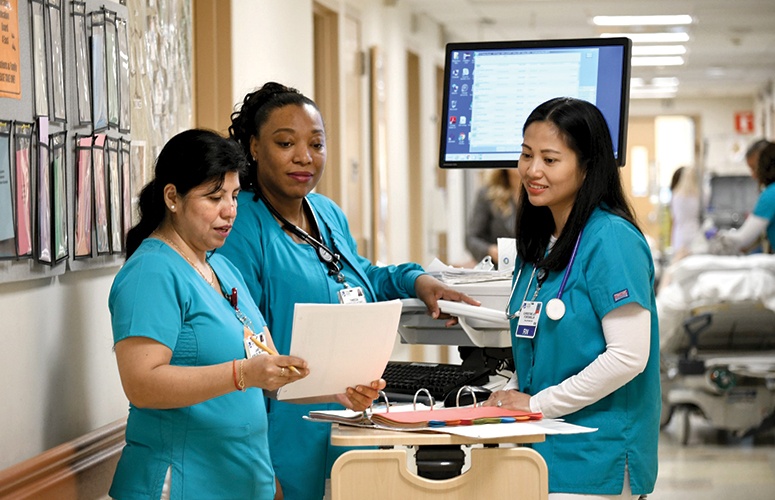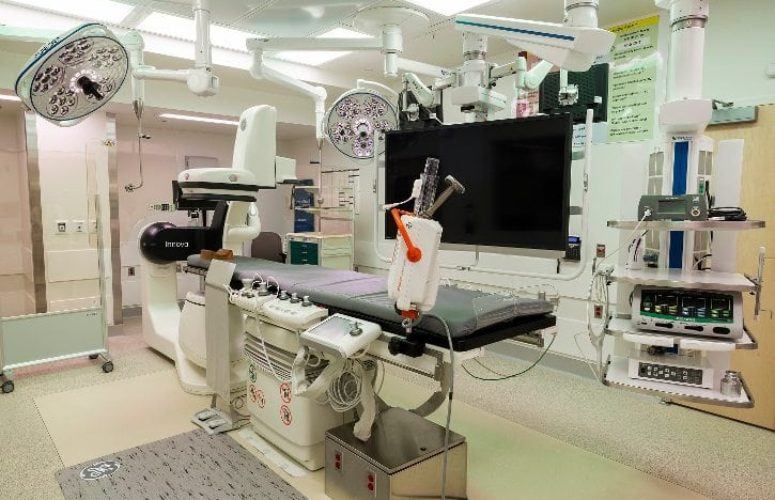
Addressing the Healthcare Professional Shortage
A look at how colleges and hospitals are enhancing career path incentives.
By Lisa Goulian Twiste, Contributing Writer On Aug 9, 2019In April, The Association of American Medical Colleges (AAMC) reported that by 2032 there will be a shortage in the US of up to 122,000 physicians, as there aren’t enough people going into the field to replace the number expected to retire in the next dozen years. On top of that, the Bureau of Labor Statistics’ Employment Projections 2016-2026 lists Registered Nursing (RN) among the top occupations in terms of growth, with a 15% increase in jobs by 2026, and more than 200,000 new RNs needed each year to fill these positions and replace retiring nurses. By 2030, New Jersey is expected to be short 11,000 nurses – the third largest deficit of any state, according to the U.S. Health Resources and Services Administration.
“The healthcare landscape is changing quickly with a physician workforce that’s aging and a number of physicians retiring, which is estimated to be increasing the next few years,” says Annette Reboli, MD, dean of Rowan University Medical School and a professor of medicine with a specialty in infectious diseases. “The good news is, the number of nurse practitioners (NPs) and physician assistants (PAs) are increasing. They are part of the solution if they practice to the limit of their licenses and free up physicians to do what only they can do,” she says.
Still, the numbers are daunting. Two of every five active physicians will be 65 or older in next 10 years, with 40 percent of the workforce expected to retire during that period. The impending shortage promises to hit New Jersey harder than most, as the state produces the fewest new practicing physicians and has the third-oldest workforce, third-highest percentage of physicians over age 60, and second-lowest percentage under 40. The increasing number of patients being insured, coupled with the growing number of Americans over age 65 and needing more care, make it all the more important to increase the pool of available physicians, highly qualified nurses and other health professionals.
Addressing the Issue
Cooper Medical School of Rowan University was founded in Camden in 2012, and according to Reboli, one of the reasons the school was placed at Rowan was to address New Jersey’s growing needs. In one program, the Health Resources and Services Administration (HRSA) provides a grant to allow students interested in primary care to complete medical school in three years instead of four and come into the workforce earlier. These students are guaranteed a residency at Cooper Hospital and, contingent on performance, become eligible for recruitment to practice at Cooper and receive loan forgiveness if they stay employed at the hospital. “It’s ‘three plus three’ – three years medical, three years residency – and once the grant is over, we are going to go large with this program,” Reboli says. “Students can go into any specialty and sub-specialty field from there.”
Hackensack Meridian School of Medicine at Seton Hall University opened in 2018 with a major goal of increasing the number of physicians in New Jersey, which is on track to be 3,000 short by the end of 2020, according to Robert C. Garrett, CEO of Hackensack Meridian Health. Half the students in the first-year class are from New Jersey, which is an inherent part of the program because it increases the likelihood graduates will practice here in the future. “We want to keep the best and brightest in New Jersey, where they are needed, especially in primary care,” Garrett says. “We know physicians typically practice where they train, and our graduates will have the opportunity to train in our network’s 17 hospitals.”
The school has been nationally recognized for its innovation, such as offering a three-year path to residency, which makes a degree more affordable and gets physicians in the pipeline faster. Second, it focuses on interdisciplinary learning so medical students, nurses and allied health professional train as a team, and the third element is the “human dimension approach,” which pairs students with patients from underserved communities throughout their training. “As we have come to recognize the importance of social factors on health outcomes, we better understand that health and wellness occur in the community, not in the hospital,” Garrett says.
Also trying to increase the number of physicians studying and staying in New Jersey is Inspira Health, which established a residency at its Vineland facility about eight years ago to retain physicians in areas like Primary Care, Obstetrics and Surgery. This year, there will be 161 participants in the program, and Inspira is hoping to develop a similar program at its new Mullica Hill campus that would add between 100-125 residents to the ranks with the goal of keeping them in the community. This expansion would make Inspira’s program one of the largest residencies in New Jersey.
As part of its recruitment efforts, Inspira also has a loan forgiveness program for residents who practice in certain specialties like Primary Care, Urgent Care, Obstetrics and some surgical specialties, and are willing to commit to practice in Cumberland County for four years. “This is a great vehicle for those residents who wish to come to an area that has significant medical needs – they will be very busy because the needs are so great – and they can receive significant loan forgiveness on their medical education student loans while they practice,” says Claire Sapienza–Eck, vice president of business development for Inspira.
In addition, Inspira is also working with Rowan University on a strategy to enhance education in the southern New Jersey region. “This collaboration, while in its infancy, has great possibilities and could range from enhancing educational opportunities in medical technical training, bio-engineering, and/or allied health, all the way to the more advanced degrees relative to medical school rotations and, finally, medical residencies,” says Sapienza-Eck. “We see the value of growing a ‘Meds and Eds’ partnership with Rowan and have seen other such successful programs across the country.”
A Shortage of Nurses and Nursing Faculty
According to Linda Flynn, PhD, RN, FAAN, senior associate dean, nursing science professor at the Rutgers School of Nursing, there will be a “tsunami” of nurses retiring in the next five years, and the physician shortage is making the demand for highly qualified nurses even greater. But the cost associated with attaining an advanced nursing degree – which averages around $70,000 – is giving pause to many would-be applicants. Compounding all of this, according to a recent American Association of Colleges of Nursing survey, there were 1,700 nursing faculty vacancies in 2018 across the US, which led to 75,000 qualified nursing school applicants being turned away because there weren’t enough faculty to teach them. Of this, 91% of the schools with vacancies would like to see them filled with PhD-prepared nurses – a tall order in this challenged marketplace.
“At Rutgers, we’re one of the least expensive schools in the region. Even so, it costs a lot of money to get a PhD, and there’s a lack of funding for tuition assistance,” says Flynn, pointing out that Rutgers is ranked in the nation’s Top 20 Doctor of Nursing programs, graduating 140 NPs a year. “All layers contribute to the nursing shortage. It’s multi-dimensional.”
To address the faculty situation, Rutgers has created teaching assistant positions for PhD students and will pay 100% of their tuition/fees and a small stipend for up to three years if they will teach undergraduates. In addition, the federal government will forgive a portion of a graduate’s loans if he or she teaches at a school of nursing for five years. Rutgers has also created a post-bachelor to doctor of nursing practice and a post-bachelor to PhD – both programs taking about five years to finish – with the idea of getting more nursing students through these rigorous programs in a timely manner and with less debt. “We’ve streamlined the curriculum to allow students to graduate with a masters and PhD, developing creative educational pathways to stoke the pipeline,” Flynn adds.
The New Jersey Collaborating Center for Nursing (NJCCN) is in the process of developing a statewide nurse residency program based on the national model, Vizient, with a projected 2020 rollout. The goal is to increase retention by providing graduates with the support they need to transition to a hospital-based career. And as the number of RNs finding jobs in hospitals (54%) continues to decline because of the aging population, the university’s out-of-hospital nurse residency program – part of a $4.7-million grant through 2022 – helps transition graduates to ambulatory care centers, nursing homes, assisted living facilities and home care.
“One of the things we are looking at closely is not so much numbers of RNs, but more about distribution of nurses,” says Edna Cadmus, PhD, clinical professor and specialty director of the nursing leadership program at Rutgers, and the executive director of NJCCN. “We are certainly preparing nurses to take that leap and matching them to what the needs will be in the future, particularly for those in vulnerable populations.”
Hospitals in Need of Qualified Nurses
Educational efforts to produce more nurses can’t come quickly enough for most hospitals, including CentraState, which has been struggling to find experienced applicants in specific modalities for more than two decades. “There has been a tight squeeze on mid-level roles in last three years and we’re looking at different ways to think outside the box when it comes to addressing these shortages,” says Tony Cipriano, CentraState’s director of talent acquisition. “We’re starting to see a trend throughout healthcare to utilize tuition reimbursement and help facilitate growth and build out jobs for them.”
CentraState’s RN Residency program supports newly hired graduates during their transition from classroom and clinical to their first work experience, helping develop and build on clinical, technical, critical thinking, delegation and organizational skills over a six- to nine-month period – at the end of which they are asked to make a two-year commitment to work at CentraState. There’s also a 10-week summer Nurse Extern program that gives students about to enter their senior year a chance to work side by side with an experienced nursing professional. A weekly lecture series addresses topics, from skin and wound care to oncology issues, and many externs have gone on to become MSTs (multiskilled technicians), PCTs (patient care technicians) or, after graduating, come back to CentraState to do an RN residency.
According to Deborah Gianchetti, director of nurse recruitment, Inspira Health, her organization’s most pressing needs are in specialized areas such as emergency services, surgical services, and labor and delivery. To address these shortages, the group runs an 18-week in-house training initiative in emergency services where nursing students receive classroom instruction with a clinical piece – after which the nurse commits to work in the ER for three years. If they resign in that time, they are required to pay back the cost of the program. More recently, Inspira started a similar program in surgical services with a training period of six months, which also includes a three-year commitment. “These programs have been very successful. People recruited into both programs have stayed with us,” Gianchetti says.
Since May of 2018, Inspira has also been offering up to $10,000 in tuition reimbursement to full-time employees who hold an associates degree and are set to obtain theirs bachelor’s degree in nursing within two years of their date of hire. In another area with shortages – lab services – Inspira is partnering with Rowan University on a program where people can get an associates degree from Cumberland, Gloucester or Camden Community College and then finish their bachelor’s degree at Rowan; or, there’s also a conversion program where a person who holds a degree in biology can easily transition to lab services.
Jose A. Balderrama, vice president of human resources at Ridgewood-based Valley Health System, says his facility has needs in the areas of nursing, patient care associates, certified medical assistants, and lab positions. He particularly points out a shortage in experienced and Advanced Practice Nurses (APNs), with an increased need over the last 12 months. “It is not getting better and probably will be a bigger issue as we see the retirement of experienced staff in the workforce,” he says. “So, we’re continuing to work on developing our own – hiring more new graduates. We offer tuition reimbursement and have agreements with educational institutions.”
Balderrama also sees nurses pursuing advanced degrees to become APNs or PhDs, which could potentially help with physician shortages as well. “There is a trend to be more accepting of APNs in providing some of the care which has in the past been reserved for or identified with physicians, so this could alleviate some of that need if physicians are not available in a particular market or region,” he says.
No doubt, the roles of physicians and nurses will continue to evolve as New Jersey’s healthcare community tries to combat shortages and service the state in the years to come. Inspira’s Sapienza–Eck points out that when she started in the field 25 years ago, the term Nurse Practitioner was nearly unknown. Now these “Physician Extenders” like NPs and/or PAs are essential as physicians are stretched thin and must delegate tasks to other staff members, she says, adding, “Growth in this area has been tremendous. I would say they’ve taken on huge responsibilities.”
To access more business news, visit NJB News Now.
Related Articles:





